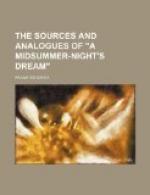[79] Chap, xxv. (E.E.T.S. edition, 72). Oberon recites his history again in chap. lxxxiv. (p. 264).
[80] Chap. xxii. (E.E.T.S. edition, p. 65, sqq.).
[81] Cf. Child’s Ballads, Nos. 2 (The Elfin Knight), 4 (Lady Isabel and the Elf-Knight), 41 (Hina Etin), and perhaps 35 (Allison Gross), with his note on the last, l. 314, referring to No. 36 (The Laily Worm and the Machrel of the Sea).
[82] See above, p. 51.
[83] See p. 124, l. 39.
[84] Tarlton’s News out of Purgatory, published by Robin Goodfellow (1590), Shakespeare Society reprint, p. 55.
[85] See above, p. 41.
[86] See the extracts from Scot’s Discovery of Witchcraft and the Robin Goodfellow tract, pp. 133-140 and 81-121.
[87] Romeo and Juliet, I. iv. 33-94. See above, p. 37.
[88] Had I been able to find a book, Veridica relatio de daemonio Puck, referred to in the article Diable in the Dictionnaire des Sciences Occultes (in Migne, tome 48, vol. i., p. 475), it might be that it would prove of great interest. In any case this allusion (pointed out to me by Mr. R.B. McKerrow) is an early instance of Puck used as a proper name.
[89] Abbreviated from E.K. Chambers’ full analysis with references, Warwick Shakespeare edition of M.N.D. pp. 142-4.
[90] See II. i. 155.
[91] How far Shakespeare associated his fairy queen Titania with her nominal parent Diana, is a question that would make matter for an elaborate study in mythology and mysticism, and might yet lead to no result. Diana is Luna in the heavens; Lucina (the goddess of child-birth) and the Huntress on earth; and Hecate in the underworld, goddess of enchantments and nocturnal incantations, often also identified with Proserpina. Titania is a votaress of the moon; we have seen that fairies are intimately concerned with mortal babies, and that there is a fairy-hunt (see the quotation from James I’s Demonology, p. 37 above); and we have also noted the confusion of Proserpina with the fairy-queen.—The Tuatha De Danann are said to be “the folk of Danu”—who is Danu? Hecate was called Trivia, on account of the above tripartition of Diana; her statues were set up where three roads met, and the fairy-queen in Thomas the Rhymer points out to him the three roads that lead to heaven, hell, and elf-land. Speculation is easily led astray.
[92] J.M. Synge, Aran Islands, p. 10.
[93] The metamorphosis of Hyacinthus, for instance, Bk. X, 162, sqq.; although there are others in the same book. See also the alteration in the mulberry caused by Pyramus’ blood (pp. 77-80).
* * * * *
ILLUSTRATIVE TEXTS
TEXTS




